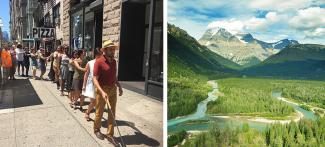Carmen Papalia & Michelle Tung
Carmen Papalia on accessibility as social practice and Michelle Tung on access, connection and translation in advancing the interests of Aboriginal communities
222 East Georgia Street
Vancouver, BC
A series of informal session of research and knowledge exchange, join us for the final session of the series with these brief presentations followed by discussion:
Carmen Papalia will present on his last few years of practice-based research on the topic of organizing for accessibility and mutual aid. Papalia will discuss projects leading up to and including his recent conceptual work Open Access; a new, relational model for accessibility that sets a precedent for considerations of agency and power in relation to the disabling social, cultural, and political conditions in a given context.Based on her work with Upper Fraser First Nations in natural resource management, Michelle Tung will discuss the tension between their interests and those of environmental assessment processes. Exploring what is made visible and invisible, and for who, Tung will share her experience on how themes of access, connection, and translation can provide creative spaces to advance the interests of Aboriginal communities.
*
Born in Vancouver, unceded Coast Salish Territory in 1981, Carmen Papalia is a Social Practice artist and non-visual learner who makes participatory projects about access to public space, the art institution, and visual culture. His work has been featured at: The Solomon R. Guggenheim museum, New York; the Harvard Art Museums, Cambridge; the Tate Liverpool, Liverpool; and locally at Gallery Gachet and the Surrey Art Gallery. Papalia is the recipient of the 2014 Adam Reynolds Memorial Bursary and the 2013 Wynn Newhouse Award. He holds a Bachelor of Arts from Simon Fraser University and a Master of Fine Arts with a focus in Art & Social Practice from Portland State University. His current work includes the multifunctional acoustic mobility device that he produced with Sara Hendren’s Investigating Normal lab at Olin College of Engineering, and “Lets Keep in Touch” a collaboration with curator Whitney Mashburn that sets a precedent for haptic criticism to become a viable practice within contemporary art.
Michelle Tung has extensive interdisciplinary experience in natural resource management with a focus on the interests of Aboriginal communities, First Nation-Crown consultation and collaborative processes. Her work includes the assessment of impacts of various natural resource development and extraction proposals in relation to Aboriginal title, rights, and interests. She has worked with First Nations organizations province-wide and in particular in the Upper Fraser watershed.
*
Image Left: Documentation from Blind Field Shuttle, 2016, photo by William Furio
Image Right: Upper Fraser Fisheries Conservation Alliance (UFFCA)
*
The Foreshore is a collaborative pursuit and shared space between Access Gallery and Other Sights. The Foreshore is inspired by the deep influence of the waterways on our cities and societies on the West Coast. As a place of unclear jurisdiction, and thus of contestation, friction, and constant movement, those who dwell in this zone must continually adapt to a changing environment. As a site it conjures histories specific to this region: narratives of trade and exchange, habitation and nourishment, resistance and violent erasure. Considering the potential of this zone as both concept and site, the project asks the following: How do we generate conditions of emergence? How can we take up space differently? How do we support unruly practices and futures?
Over the last 7 months, the storefront adjacent to Access’ gallery space at 222 East Georgia has hosted bi-weekly open discussion sessions informed by invited artists, writers, curators, and activists. Adding to this exciting program, we have launched an artist-in-residence series to provide space and time to artists interested in addressing questions of The Foreshore
Accessibility Info
Front door: width 35 inches. Front door step: height 4 inches. No ramp.
Hallway door: 35 inches. Washroom door: 29 inches width. Toilet: 12 inch clearance on left side, 19 inch clearance from toilet to sink. The washroom has no handrail. Washroom is all genders.
*
Other Sights for Artists’ Projects is a non-profit arts organization that develops new and unexpected exhibition platforms outside of the gallery context. Other Sights collaborates and shares resources with organizations and individuals to present artworks that consider the aesthetic, economic and regulatory conditions of public places and public life. For more information visit othersights.ca
Other Sights gratefully acknowledges the support of the British Columbia Arts Council, The Canadian Union of Public Employees Local 15, and private donors without whom this project would not be possible.
*
Established as an non-profit artist-run centre in 1991, Access Gallery is platform for emergent and experimental art practices. We enable critical conversations and risk taking through new configurations of audience, artists, and community. For more information visit accessgallery.ca.
Access Gallery gratefully acknowledges the support of the Canada Council for the Arts, the Government of British Columbia through the BC Arts Council and BC Gaming, the City of Vancouver, the Hamber Foundation, the Burrard Arts Foundation, the Contemporary Art Gallery, and our committed donors, members and volunteers.
